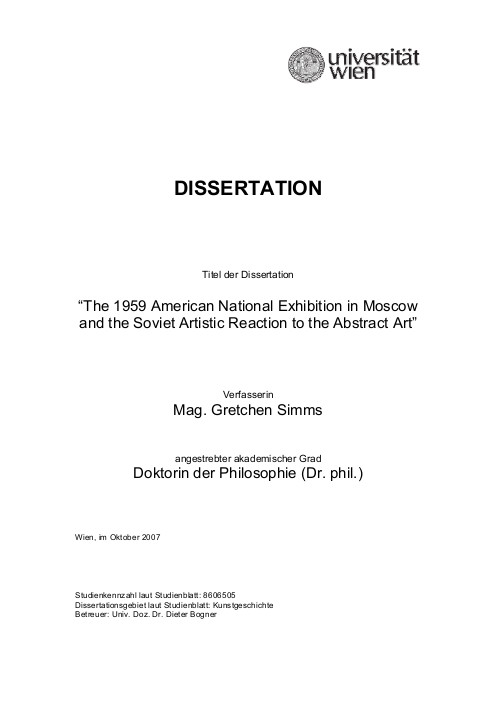Gretchen Simms: The 1959 American National Exhibition in Moscow and the Soviet Artistic Reaction to the Abstract Art (2007)
Filed under thesis | Tags: · abstract art, abstract expressionism, art history, cold war, cultural politics, politics, soviet union, united states

“The American National Exhibition was an exchange exhibition organised by the United States Information Agency (USIA) and took place at Sokolniki Grounds in Moscow in 1959. The overall director George V. Allen and the Association of Federated Artists (AFA) Vice President Lloyd Goodrich, who was also President of the Whitney Museum of American Art in New York, were responsible for the art section of the Exhibition. The art committee selected, intended to show the Soviet public the developments in modern American art since World War I.
The Soviet response to the Exhibition can only be fully appreciated by looking back at the developments within Russian and Soviet art as well as the political and social changes which the peoples in the Soviet Union experienced under Khrushchev. Through the analysis of the Soviet reception of the Exhibition, this dissertation shows how the Soviet public and especially the artworld in Moscow perceived specifically the American abstract art.
It reveals how the American abstract art displayed at the Exhibition facilitated the Soviet artists path in looking back at their Russian roots, looking within themselves and looking outside of their immediate boundaries in order to create new Soviet art.” (from the Abstract)
Art History, University of Vienna
Supervisor Dieter Bogner
191 pages
Stephen Bann (ed.): The Tradition of Constructivism (1974)
Filed under book | Tags: · art, art criticism, art history, avant-garde, constructivism, productivism, russia, soviet union

“With these words the sculptors Naum Gabo and Antoine Pevsner pronounced the official birth of constructivist art, the most revolutionary, challenging, and enigmatic of twentieth-century artistic movements. Since the time of their ‘Realistic Manifesto’, constructivism has spread throughout the world, opposing personal, expressionistic art with abstraction and formal construction. In this book, Stephen Bann has collected the most important constructivist documents, including the writings of El Lissitzky, Theo Van Doesburg, Hans Richter, Victor Vasarely, and Charles Biederman—many of which have never before been available in English—and supplemented them with a critical introduction, a chronology of constructivism, and an invaluable bibliography of close to four hundred items. This volume is illustrated with thirty-eight constructivist prints, paintings, drawings, and sculptures, some of them are rare and previously unpublished.”
With an introduction by Stephen Bann
Publisher Viking Press, 1974
Documents of 20th-Century Art series
ISBN 0670019569, 9780670019564
334 pages
Review: Susan Compton (Slavic Review 1975).
PDF (no OCR; updated on 2012-7-15)
Comment (1)Walter Benjamin: Moscow Diary (1980–) [EN, ES]
Filed under book | Tags: · 1920s, art, avant-garde, literature, moscow, revolution, russia, soviet union, theatre

The life of the German-Jewish literary critic and philosopher Walter Benjamin (1892-1940) is a veritable allegory of the life of letters in the twentieth century. Benjamin’s intellectual odyssey culminated in his death by suicide on the Franco-Spanish border, pursued by the Nazis, but long before he had traveled to the Soviet Union. His stunning account of that journey is unique among Benjamin’s writings for the frank, merciless way he struggles with his motives and conscience.
Perhaps the primary reason for his trip was his affection for Asja Lacis, a Latvian Bolshevik whom he had first met in Capri in 1924 and who would remain an important intellectual and erotic influence on him throughout the twenties and thirties. Asja Lacis resided in Moscow, eking out a living as a journalist, and Benjamin’s diary is, on one level, the account of his masochistic love affair with this elusive–and rather unsympathetic–object of desire. On another level, it is the story of a failed romance with the Russian Revolution; for Benjamin had journeyed to Russia not only to inform himself firsthand about Soviet society, but also to arrive at an eventual decision about joining the Communist Party. Benjamin’s diary paints the dilemma of a writer seduced by the promises of the Revolution yet unwilling to blinker himself to its human and institutional failings.
Moscow Diary is more than a record of ideological ambivalence; its literary value is considerable. Benjamin is one of the great twentieth-century physiognomists of the city, and his portrait of hibernal Moscow stands beside his brilliant evocations of Berlin, Naples, Marseilles, and Paris. Students of this particularly interesting period will find Benjamin’s eyewitness account of Moscow extraordinarily illuminating.
First published as Moskauer Tagebuch, Suhrkamp, 1980
English edition
Preface by Gershom Scholem
Translated by Richard Sieburth
Edited by and Afterword by Gary Smith
Published in October journal 35, Winter 1985, MIT Press
ISBN 0262751852
151 pages
Moscow Diary (English, 1985, no OCR; updated on 2012-7-18)
Moscow Diary (English, 1985, OCR; missing Preface and Afterword; updated on 2012-7-18)
Diario de Moscú (Spanish, trans. Marisa Delgado, 1990, added on 2014-3-10)

